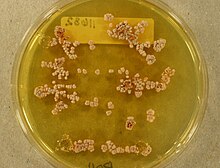Aspergillus alabamensis
| Aspergillus alabamensis | |
|---|---|
 |
|
| Scientific classification | |
| Kingdom: | Fungi |
| Division: | Ascomycota |
| Class: | Eurotiomycetes |
| Order: | Eurotiales |
| Family: | Trichocomaceae |
| Genus: | Aspergillus |
| Species: | A. alabamensis |
| Binomial name | |
|
Aspergillus alabamensis Balajee (2009) |
|
Aspergillus alabamensis is a soil fungus in the division Ascomycota first described in 2009 as a segregated taxon of A. terreus. Originally thought to be a variant of A. terreus, A. alabamensis is situated in a distinctive clade identified by genetic analysis. While A. alabamensis has been found to be morphologically similar to Aspergillus terreus by morphological studies, the two differ significantly in active metabolic pathways with A. alabamensis producing the mycotoxin citrinin and citreoviridin but lacking mevinolin.
Aspergillus alabamensis was discovered by Balajee and colleagues in 2009 while investigating the cryptic lineages in A. terreus in a multilocus sequence typing (MLST) study of three protein-encoding genes: enolase (enoA) β-tubulin (benA) and calmodulin (calM). They chose the species epithet "alabamensis" to reflect their geographic origin of strains comprising the new clade with 11 of the 14 isolates originating from clinical specimens obtained from the University of Alabama at Birmingham. The other 3 isolates were derived from soil samples collected in Argentina and Florida.
A. alabamensis produces slow growing colonies that are wooly and white becoming yellow-brown to cinnamon-brown in colour with the onset of asexual sporulation. Conidiophores are colourless and smooth with densely columnar conidial heads 30–50 μm in diameter and 150–500 μm in length. The vesicles are subglobose with a diameter of 10–16 μm. The metulae attached to the vesicles are closely packed, measuring 5.5–7.5 μm long by 1.5–2.0 μm wide. Phialides attached to the apices of the metulae are 5.0–7.0 μm long by 2.0–2.5 μm wide. The conidia arising from the tips of the phialides are slightly elliptical and smooth-walled reaching a diameter of 1.8–2.4 μm. While Aspergillus alabamensis can grow between 25–50 °C, its optimal growth temperature is 37 °C.A. alabamensis can grow in vitro on a range of growth media including potato flake agar, carnation leaf agar, Czapek's yeast autolysate agar, and malt extract agar. This species is able to utilize glucose and sucrose as sources of carbon.
...
Wikipedia
